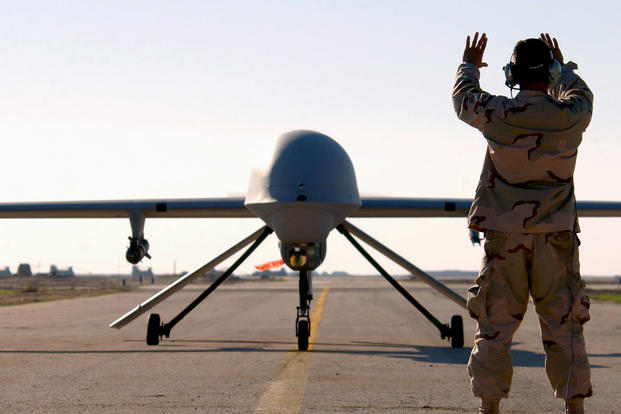It's no secret that the reign of the Air Force's MQ-1 Predator drone is slowly coming to an end.
So crews with the 46th Expeditionary Reconnaissance and Attack Squadron have been overlapping their launch and recovery missions with the MQ-9 Reaper as the larger, more lethal drone comes into its own.
"It's in the process, Air Force-wide. We're just going to continue to see less MQ-1 lines and more MQ-9," said Lt. Col. Jason, commander of the 46th ERAS, inside an MQ-1 hangar.
Military.com spoke with the commander and a pilot with the squadron, part of the 386th Air Expeditionary Wing, on a recent trip to the Middle East, on the condition that last names not be used due to safety concerns amid ongoing air operations against the Islamic State of Iraq and Syria, or ISIS.
The airmen, on call for the MQ-1 mission 24/7, said moving to the MQ-9, also stationed at the base, will require a few tweaks, but the launch and recovery process should be the same.
"It's different qualifications -- but as far as takeoff and landing, it's very similar," Jason said.
Related content:
- Air Force Seeks to Change How Drone Pilots Train, Fly
- Drone Milestone: More RPA Jobs Than Any Other Pilot Position
- Airmen Fighting ISIS Talk Future Electronic Attack Aircraft EC-X
- More BACN, Please; Data Node for Global Hawks in High Demand
- The Air Force's Newest MQ-9 Reaper Drone Is Now Hunting ISIS
The transition from the Predator to the Reaper -- slated to be complete in 2018 -- will be widespread, given the 386th AEW isn't the only base in the Middle East housing the older aircraft.
"We're one of several MQ-1 missions" out here, Jason said, without disclosing how many unmanned aerial vehicles, or UAVs, are operating in the theater.
The 46th facilitates only launch and recovery, base officials emphasized. Any strike operations manifested in the air are controlled by airmen at Creech Air Force Base, Nevada.
For this unit, it's the behind-the-scenes, down-and-dirty work to keep the MQ-1 flying -- even if only for a little while longer.
MQ-9: Easier Mission?
An all-MQ-9 mission may make life easier and more efficient for crews downrange. Currently, more MQ-9 hangars are being built at the 386th, as Military.com witnessed.
But officials at the base said they might miss the flexibility of having two platforms at their disposal.
It increases the "options that we have," Jason explained. "If we were only an MQ-9 base, and the weather was really bad, and there's MQ-1s that are airborne, we may not be able to receive them if we didn't have qualified MQ-1 crews" here.
"It helps with that flexibility if we'd need to divert," he said.
On the other hand, getting more relief for their maintenance crews has been an unspoken wish.
"Our maintenance lead, he was saying that this plane [the MQ-1] was designed really quickly and it wasn't designed as intelligently as it could have been," said Capt. Mike, an MQ-1 pilot.
"A lot of stuff is more complicated than it needs to be, so … the [MQ-]9 is a little easier to work on," Mike said.
Drone Compadres
Together, the MQ-1 Predator and MQ-9 Reaper medium-altitude unmanned aircraft represent the "largest major weapons system the Air Force has right now," Air Combat Command officials told Military.com in October.
In March, officials announced the service now has more jobs for MQ-1 and MQ-9 UAVs than any other type of pilot position.
Officials have typically coupled the drones, made by General Atomics, for intelligence, surveillance and reconnaissance missions -- especially in the air war against ISIS, in which the drones have provided intelligence before a strike.
For example, controllers are sometimes using multiple Reapers, Predators or both "combined in a formation to go out and execute, because we know they're more efficient in using their sensors when they're tasked together, having airmen leading airmen," said Lt. Col. Eric Winterbottom, chief of the Commander's Action Group, U.S. Air Forces Central Command.
"If you have two aircraft working the same target, then one can guide the weapon in, while the other one takes a larger, zoomed out view to look for things you don't want the missile to hit," Winterbottom said in October, referencing the Hellfire missiles both platforms carry.
Jason echoed the chief's methodology.
"There's a high demand not only for the persistent reconnaissance that we bring, but the persistent attack piece as far as weapons deployment," Jason said. "We can identify targets for other strike platforms."
The Predator: 'Its Own Airplane'
The MQ-1 has proved itself as a strike and surveillance platform -- flying an average of 20 hours per mission, Jason said -- especially early in the wars in Iraq and Afghanistan. It's been in service for more than 20 years.
Describing the "checkpoint" procedures crews take before they launch the craft, Jason said no MQ-1 is like any other.
"Each airplane is its own airplane, it has a slightly different weight, a slightly different fuel load," he said. That includes how many AGM-114 Hellfires will be loaded onto the MQ-1 before it takes off (the drone can carry two).
They don't always max out the MQ-1's capacity of 450 pounds in Hellfire munitions.
"We may not always ... carry all of weapons we could carry, because sometimes there's a tradeoff between weapon weight or fuel weight, and normally [operators] want to maximize the fuel weight," said Jason.
The weight-and-balance measurements matter, said Mike, because "if I take off that [MQ-1], I'm not necessarily going to land that one," so understanding each aircraft is key to how it may perform.
Pointing into the distance, Jason added, "MQ-9s are on the other end of the field. They're much larger -- they were designed from the ground up as an attack platform, so they can carry more ordnance and more fuel."
By comparison, the MQ-9 has a payload of 3,750 pounds, and carries a combination of AGM-114 Hellfire missiles, GBU-12 Paveway II and GBU-38 Joint Direct Attack Munitions, according to the Air Force.
While the MQ-1 has a lower fuel capacity, at just 665 pounds, the Reaper's fuel intake is exponential -- a maximum capacity of 4,000 pounds, or roughly 600 gallons.
Watching the Weather
Weather has always been key during launch, the MQ-1 pilot said. "We … make sure we're in our limits of taking off, and what weather we're flying into.
"There's a system that we monitor for all the aircraft in the [area of responsibility], and the ones that we're taking off," Mike said.
Extreme heat and dust storms haven't been kind to this aircraft, Jason added, saying the unit has had issues with overheating on the aircraft.
"That's why it's good to have other locations, so if we're not able to safely launch and recover here, hopefully another location can," he said.
When asked if temperature-controlled hangars -- some already in use across the service for planes such as the F-22 Raptor, which has delicate stealth coating -- could help offset damage caused by weather, Jason said, "That would be great, but like anything, that costs money. A lot of this is expeditionary in nature, but … it would be nice to have a ... permanent hangar to work out of."
He said the MQ-1's upgrade iterations play a role. With "adding stuff on and squeezing stuff in all along … I've heard that it gets difficult to work on in certain areas."
Line-of-Sight Retrieval
Before it says farewell, the MQ-1 will continue to share runways with the MQ-9 here.
When the crews get ready to receive it on the flight line, Mike said, "There's a line-of-sight link we need to control directly with the [MQ-1]."
"The [drone operators] at Creech, they're flying with a different type of satellite link, and there's about a two-second delay in that, so when they input a control, the aircraft takes a little while to transmit that signal to make the plane go where they want it to," Mike said.
Like units at Creech, the 46th also uses a pilot and sensor operator, acting as a co-pilot, in theater to control the UAV.
Touring the base's ground control station trailer, Jason pointed out, "It has the same controls as any other aircraft -- a control stick, a throttle and there's rudder pedals down there too."
Once the daily mission is done, the home-base ground control station will switch the sat links over to the crews in theater, who then prepare to grab the drone -- using GPS to relay its location -- back.
There are procedures in place should the link not relay, but more often than not, the remotely piloted aircraft pops into view, and, these days, could be coming from any hot spot in the Middle East.
"We open [its] eyes and see, 'Oh, it's there,' " Mike said.
-- Oriana Pawlyk can be reached at oriana.pawlyk@military.com. Follow her on Twitter at @Oriana0214.
Related Video:




























